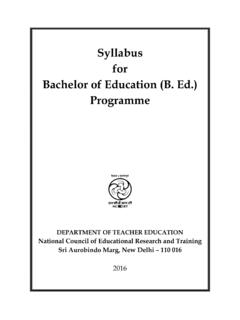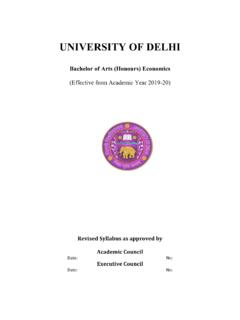Transcription of Education System in Myanmar Brief Description of Primary ...
1 Education System in Myanmar Brief Description of Primary , secondary and tertiary Education 1 Basic Education System The current basic Education System in Myanmar comprises six years of Primary (Grade 1 to Grade 6), three years of lower secondary (Grade 7 to Grade 9) and two years of upper secondary (Grade 10 and Grade 11) Education . There are currently 47, 365 basic Education schools in Myanmar with approximately million students. The majority of these schools are managed by the Department of Basic Education under the Ministry of Education (MOE). In addition, a significant percentage of students access basic Education through monastic, private, community and ethnic Education schools. The official commencement date for schools in Myanmar is 1st June every year. The number of schools, teachers and students in the basic Education in the 2015-2016 Academic Year are listed in Table - 1 below.
2 Table - 1: Number of Schools, Teachers and Students in the 2015 - 2016 Academic Year. S. No. School Category Number of Basic Education Schools (2016) Number of Teachers Number of Students 1 Upper secondary 3, 515 34,393 873,832 2 Lower secondary 6,224 129,945 2795,607 2 3 Primary 35,650 158,176 5,184,041 4 Monastic 1,538 11,044 297,039 5 Private 438 7,397 107,451 Total 47,365 340,955 9,257,970 2. Preschool and Kindergarten Preschools are opened for children over 2 years and they are in extensive care or public systems. Kindergarten starts from the age of 5 (not younger than 4 Years and 8 months at the time of school's commencement date). Primary , Lower secondary and Upper secondary Schools in Myanmar are under the Department of Basic Education of the Ministry of Education . 3. Primary Education Primary Education is the first stage of basic Education and, in principle, is compulsory.
3 Primary Education lasts five years, including one year of pre-school Education (kindergarten); it is organized in two cycles: lower and upper Primary . The admission age is 5+. It lasts six years and to proceed to the 3 secondary school, students must pass a comprehensive examination of basic subjects after Standard 4. KG starts at the age of 5 and actual teaching - learning process already begins in KG. 4. secondary Education secondary Schools are usually combined, comprising both middle and high schools. secondary Middle Schools offer Standard 5 to Standard 8 (lower secondary level) whereas secondary High Schools Standard 9 and Standard 10 (Matriculation) (upper secondary level). The first phase of secondary Education takes place at Middle Schools, where students pass through Standard 5 to Standard 8 before they take their Standard 8 examinations.
4 In High Schools, all students have to take Myanmar , English and Mathematics as compulsory subjects. Arts students major in Geography, History and Economics, while science students major in Chemistry, Physics and Biology. At the end of the two-year high school period, end of 4 Standard 10 (Matriculation), students sit for their university entrance examinations (matriculation examinations) annually in March, administered by the Board of Examinations of the Ministry of Education . Students who achieve distinctions in five or more subjects (or a combined total of approximately 500 / 600 marks are generally guaranteed placement in one of technological and medical universities, the most selective of universities in Myanmar . Test score are released at testing sites throughout the country in June since 2007. 5. New Basic Education in Myanmar In 1998, Kindergarten (KG) was designated as Grade 1 and since then KG has been not for singing and playing which is normally the case internationally, but the actual teaching and learning take places in KG.)
5 Former Standard 1 syllabus is taught in KG, even though the children are only 5 years old. It can be said that academic standard in Myanmar is one year ahead of the internationally accepted age norm. 5 It seems as if what is known as Standard 10 is academically about equivalent to international Grade 11, even though the age of Myanmar students are one year younger than their international cohorts. The comparison of the Old and New Basic Education System is shown in the Diagram below; Old System New System Primary School Primary School (5 Standards) (KG + 5 Standards) Age 5 Age 6 Age 7 Age 8 Age 9 KG Standard 1 Standard 2 Standard 3 Standard 4 Grade 1 Grade 2 Grade 3 Grade 4 Grade 5 Age 5 Age 6 Age 7 Age 8 Age 9 New KG Age 10 (G1) (G2) (G3) (G4) (G5) 1st Std. 2nd Std. 3rd Std. 4th Std. 5th Std. Age 10 Standard 5 Grade 6 Age 11 (G7) 7th Std. Age 11 Standard 6 Grade 7 Age 12 (G8) 8th Std.
6 Age 12 Standard 7 Grade 8 Age 13 (G6) 6th Std. Age 13 Standard 8 Grade 9 Age 14 (G9) 9th Std. KG Lower secondary (4 Standards) (Middle School) Lower secondary (4 Standards) (Middle School) Primary ( Primary School) Primary ( Primary School) Upper secondary (2 Standards) (High School) Upper secondary (3 Standards) (High School) 6 6. tertiary Education The Rangoon University Bill was enacted in 1920. In tertiary Education System , after high school, a student had to attend for 2 years either Intermediate Arts ( ) or Intermediate Science ( ) course at the university, depending on the Arts or Science Subject Combination chosen by the student. After and , Students could select to attend Arts and Science University or any other Professional Universities such as Technological University, Medical University, Economic University etc., according to their interest and marks attained in their and courses.
7 After , those who wanted to become engineers could apply for engineering specialization at the Faculty of Engineering which required another 4 years to earn (Engg.) Degree. Therefore, to get an engineering degree, it took 10 years in High School plus 2 years as student plus another 4 years as engineering student, totaling 16 schooling years. That System was existed up to 1964, when so-called New Education System was introduced in Myanmar . The government envisions higher Education as an avenue for empowering people to make educated decisions and capitalize on economic opportunities 7 within Myanmar , and therefore, foresees investment in Education investment for the people of Myanmar . Universities in Myanmar remain highly centralized and state-run. Universities offer bachelor 's degree programmes, master's degree programmes, and doctorate degree programmes.
8 The higher Education System follows a 4-1-3 year program with a 4 years for a bachelor 's degree, one year for qualifying classes, and 3 years for a master's degree. This is true only for some kinds of institutions like Arts and Science Universities and University of Economics However, some kinds of professional universities such as Technological Universities offer long bachelor 's Degree Programmes, lasting a minimum of 6 years for the first degree. It takes another 2-3 years for Master's Degree and another 3-5 years for Doctoral Degree at the Technological Universities. Myanmar has 158 tertiary Education institutions, colleges, degree colleges and universities, which are overseen by respective Ministries. The majority of students are studying fulltime in tertiary Education under the management of the Ministry of Education , while some students are accessing higher Education through Distance Education Universities.
9 The universities are run by their respective Ministries. For example, Universities of Medicine are run by the Ministry of Health and Sports and Agricultural University is run by the Ministry of Agricultural, Livestock and Irrigation, etc. 8 7. Technical and Vocation Education Assess to Technical and Vocation Education and Training (TVET) in Myanmar is provided by relevant Ministries and the private sector. The Technical and Vocation Education and Trainings (TVETs) are mainly run by the Technical High Schools and Technical Institutes under the Ministry of Education . 8. Brief History of Engineering Education in Myanmar Myanmar Engineering Education started as the Department of Engineering which was first established under Rangoon University in 1923 and the programme for (Engg.) degree in Civil Engineering was inaugurated in 1924. In 1927, Burma Oil Company ( ) donated College of Mining Engineering in the University Estate and the formerly established Department of Engineering was moved to that place.
10 Then in 1946, the Department of Engineering was upgraded to become the Faculty of Engineering, headed by the Dean of Engineering. Myanmar gained independence from the United Kingdom in 1948 and the Department of Mechanical Engineering and the Department of Electrical Engineering were formed in 1951. At that time, there were Civil, Mechanical and Electrical Engineering Departments (3 Separate Engineering Departments) under the Faculty of Engineering of Rangoon (Yangon) University. 9 Two visiting professors from (USA) were sent to provide necessary assistance to Myanmar under the Technical Cooperation Administration (TCA) Programme between USA and Myanmar . More lecturers form USA, UK and India came later. IN 1952, some bright students were sent as scholars to several famous universities in USA, including and some more students were trained in later years.



